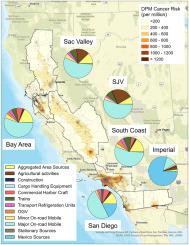Diesel particulate matter health impacts in California: Trends, source apportionment, and policy implications
IF 7.3
2区 环境科学与生态学
Q1 ENVIRONMENTAL SCIENCES
引用次数: 0
Abstract
Diesel particulate matter (DPM) has been recognized as a carcinogen and identified as a toxic air contaminant (TAC) in California and other jurisdictions. In response to this identification, the California Air Resources Board (CARB) has adopted numerous regulations aimed at reducing DPM emissions from various sources. This study utilized an integrated modeling approach to simulate ambient DPM concentrations for individual emission sectors separately for the two years 2012 and 2017. The associated health impacts, including cancer risk and non-cancer effects, were then assessed. This assessment provided a basis for apportioning emission sources, analyzing reduction trends, and informing further regulatory efforts when combined with future emissions projections.
Our results showed a significant reduction in DPM-related cancer risk in California between 2012 and 2017. Specifically, population weighted DPM cancer risk decreased by 42 %, and mortality attributable to DPM exposure decreased by about 50 % statewide. Additionally, census tracts with higher population densities consistently experienced more significant reductions in DPM cancer risk from 2012 to 2017.
Source apportionment analysis indicated that, as of 2017, on-road mobile sources were the largest contributor to overall DPM risk, followed by off-road mobile, area, and stationary sources. Our findings further suggest that while the overall health risk from DPM will continue to decline with emissions, the relative contributions of each emission sector to DPM risk may shift over time depending on the major regulations in place, and how the emission reductions impact nearby population. When accounting for how emissions have changed since 2017 and are projected to change in the future, new emission reduction efforts will likely need to prioritize off-road mobile sources (e.g., seaports, airports, locomotives) and area sources (e.g., construction and agricultural sectors) to achieve further risk reductions, especially beyond 2025.


加州柴油微粒物质对健康的影响:趋势、来源分配和政策含义
在加州和其他司法管辖区,柴油颗粒物(DPM)已被认定为致癌物,并被认定为有毒空气污染物(TAC)。作为对这一认定的回应,加州空气资源委员会(CARB)通过了许多旨在减少各种来源的DPM排放的法规。本研究利用综合建模方法分别模拟了2012年和2017年各排放部门的环境DPM浓度。随后评估了相关的健康影响,包括癌症风险和非癌症影响。这一评估为分配排放源、分析减排趋势以及结合未来排放预测为进一步的监管工作提供了依据。我们的研究结果显示,2012年至2017年间,加州与dpm相关的癌症风险显著降低。具体而言,人口加权DPM癌症风险降低了42%,在全州范围内,DPM暴露导致的死亡率降低了约50%。此外,从2012年到2017年,人口密度较高的人口普查区DPM癌症风险持续显著降低。来源分配分析表明,截至2017年,道路移动源是总体DPM风险的最大贡献者,其次是非道路移动源、区域源和固定源。我们的研究结果进一步表明,虽然DPM的整体健康风险将随着排放而继续下降,但每个排放部门对DPM风险的相对贡献可能会随着时间的推移而变化,这取决于现有的主要法规,以及减排对附近人口的影响。考虑到自2017年以来的排放变化以及预计未来的变化,新的减排努力可能需要优先考虑非公路移动源(如海港、机场、机车)和区域源(如建筑和农业部门),以进一步降低风险,特别是在2025年以后。
本文章由计算机程序翻译,如有差异,请以英文原文为准。
求助全文
约1分钟内获得全文
求助全文
来源期刊

Environmental Pollution
环境科学-环境科学
CiteScore
16.00
自引率
6.70%
发文量
2082
审稿时长
2.9 months
期刊介绍:
Environmental Pollution is an international peer-reviewed journal that publishes high-quality research papers and review articles covering all aspects of environmental pollution and its impacts on ecosystems and human health.
Subject areas include, but are not limited to:
• Sources and occurrences of pollutants that are clearly defined and measured in environmental compartments, food and food-related items, and human bodies;
• Interlinks between contaminant exposure and biological, ecological, and human health effects, including those of climate change;
• Contaminants of emerging concerns (including but not limited to antibiotic resistant microorganisms or genes, microplastics/nanoplastics, electronic wastes, light, and noise) and/or their biological, ecological, or human health effects;
• Laboratory and field studies on the remediation/mitigation of environmental pollution via new techniques and with clear links to biological, ecological, or human health effects;
• Modeling of pollution processes, patterns, or trends that is of clear environmental and/or human health interest;
• New techniques that measure and examine environmental occurrences, transport, behavior, and effects of pollutants within the environment or the laboratory, provided that they can be clearly used to address problems within regional or global environmental compartments.
 求助内容:
求助内容: 应助结果提醒方式:
应助结果提醒方式:


